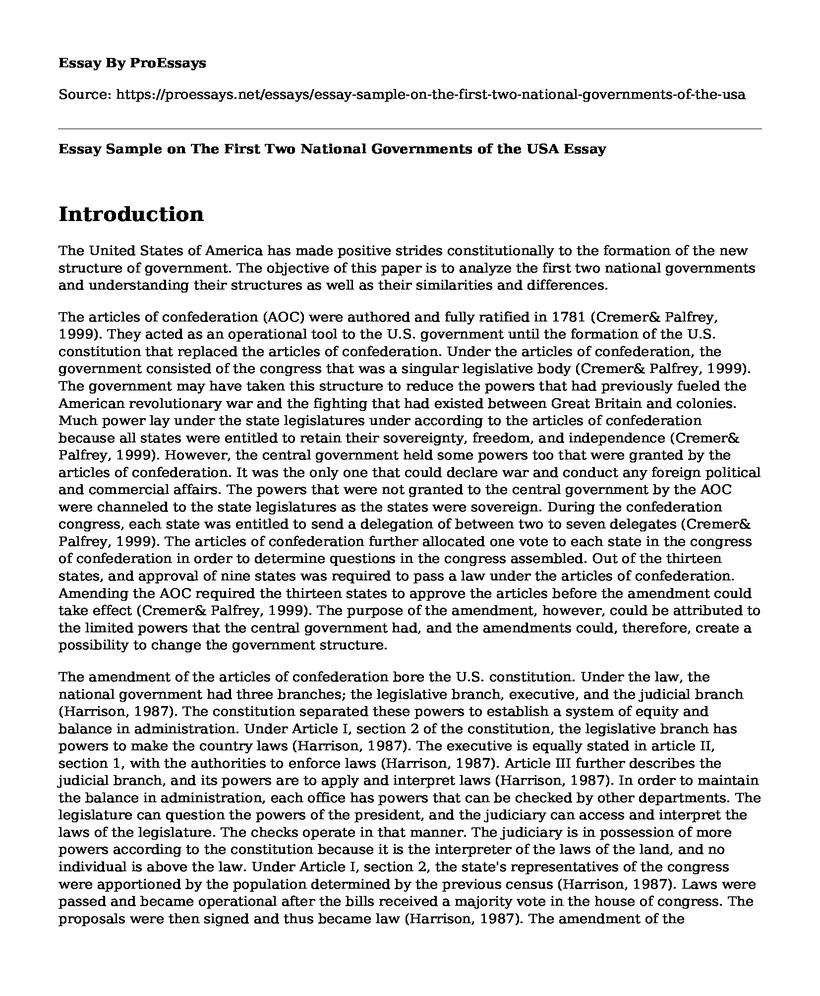Introduction
The United States of America has made positive strides constitutionally to the formation of the new structure of government. The objective of this paper is to analyze the first two national governments and understanding their structures as well as their similarities and differences.
The articles of confederation (AOC) were authored and fully ratified in 1781 (Cremer& Palfrey, 1999). They acted as an operational tool to the U.S. government until the formation of the U.S. constitution that replaced the articles of confederation. Under the articles of confederation, the government consisted of the congress that was a singular legislative body (Cremer& Palfrey, 1999). The government may have taken this structure to reduce the powers that had previously fueled the American revolutionary war and the fighting that had existed between Great Britain and colonies. Much power lay under the state legislatures under according to the articles of confederation because all states were entitled to retain their sovereignty, freedom, and independence (Cremer& Palfrey, 1999). However, the central government held some powers too that were granted by the articles of confederation. It was the only one that could declare war and conduct any foreign political and commercial affairs. The powers that were not granted to the central government by the AOC were channeled to the state legislatures as the states were sovereign. During the confederation congress, each state was entitled to send a delegation of between two to seven delegates (Cremer& Palfrey, 1999). The articles of confederation further allocated one vote to each state in the congress of confederation in order to determine questions in the congress assembled. Out of the thirteen states, and approval of nine states was required to pass a law under the articles of confederation. Amending the AOC required the thirteen states to approve the articles before the amendment could take effect (Cremer& Palfrey, 1999). The purpose of the amendment, however, could be attributed to the limited powers that the central government had, and the amendments could, therefore, create a possibility to change the government structure.
The amendment of the articles of confederation bore the U.S. constitution. Under the law, the national government had three branches; the legislative branch, executive, and the judicial branch (Harrison, 1987). The constitution separated these powers to establish a system of equity and balance in administration. Under Article I, section 2 of the constitution, the legislative branch has powers to make the country laws (Harrison, 1987). The executive is equally stated in article II, section 1, with the authorities to enforce laws (Harrison, 1987). Article III further describes the judicial branch, and its powers are to apply and interpret laws (Harrison, 1987). In order to maintain the balance in administration, each office has powers that can be checked by other departments. The legislature can question the powers of the president, and the judiciary can access and interpret the laws of the legislature. The checks operate in that manner. The judiciary is in possession of more powers according to the constitution because it is the interpreter of the laws of the land, and no individual is above the law. Under Article I, section 2, the state's representatives of the congress were apportioned by the population determined by the previous census (Harrison, 1987). Laws were passed and became operational after the bills received a majority vote in the house of congress. The proposals were then signed and thus became law (Harrison, 1987). The amendment of the constitution required a convention of two-thirds of the states, which translated to 34 states of the 50 states.
Conclusion
To sum up, the analysis of the structures of the two governments of the U.S. clearly indicates that there is a difference in the compositions. However, the structure provided by the constitution is suitable as it offers a balance of powers in administration.
References
Cremer, J., & Palfrey, T. R. (1999).Political confederation. American Political Science Review, 93(1), 69-83.
Harrison, J. (1987). Role of the Legislative and Executive Branches in Interpreting the Constitution. Cornell L. Rev., 73, 371.
Cite this page
Essay Sample on The First Two National Governments of the USA. (2023, Apr 24). Retrieved from https://proessays.net/essays/essay-sample-on-the-first-two-national-governments-of-the-usa
If you are the original author of this essay and no longer wish to have it published on the ProEssays website, please click below to request its removal:
- Pluralist and Power Elite Model of America on Sociology - Essay Example
- The Economic Implications of Government Control Over the Interest Rates Essay
- The UK Should Have Second Brexit Referendum Paper Example
- Essay on Negative Campaign Mails and Voter Turnouts: How They're Connected
- Essay Sample on Statesmanship and Civic Administration: A Political Leader's Duty
- Paper Example on Good Governance and Democratic Legitimacy: Definition and Application
- The Controversial US Flag: Respect, Discernment, and Depredation - Essay Sample







